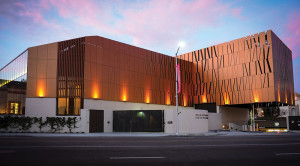Structural Focus was an Award Winner for the Wallis Annenberg Center for the Performing Arts Goldsmith Theater project in the 2015 NCSEA Annual Excellence in Structural Engineering awards program (Category – New Buildings $10M to $30M).
Completed in October 2013, the Wallis Annenberg Center for the Performing Arts project includes the restoration and seismic upgrade of the historic Beverly Hills Post Office building and the construction of the new 500-seat state-of-the-art Goldsmith Theater. The structural engineering effort was comprehensive and meticulous, requiring complex foundation work, careful restoration of the historic structure, ground-up design of the new theater, and precise coordination with the architect, acousticians, and mechanical engineers to ensure the highest acoustic performance.
In 2004, the Annenberg Foundation and other donors funded the preservation of the historic Beverly Hills Post Office building, and the creation of the Wallis Annenberg Center for the Performing Arts. Initial design concepts sought to place the main theater inside the historic structure. It soon became clear however, that in order to create a theater of sufficient size, along with the complex programming required to support it, the post office building simply was not large enough. Esteemed Los Angeles architect Zoltan Pali and his firm, Studio Pali Fekete architects [SPF:a], began developing the concept for a new structure on the site to complement the historic building and expand the capability of the performing arts complex. SPF:a determined the best way to honor the historic post office building was not through mimicry or direct reference, but through a contemporary design inspired by the historic function of the site and the beauty of its traditional neighbor.
The Goldsmith Theater is sunken into the earth, making possible a full size, 60-foot fly tower without visually overbearing the adjacent two-story post office building or the Beverly Hills City Hall across the street. The entrance to the theater is at the same level as the basement of the post office building, and a grand stair leads guests from the main level of the post office down to the Goldsmith Lobby. In the Goldsmith Theater, the trap level underneath the stage is approximately 30 feet below street level. The foundation design carefully considered the impact to and from a new subterranean parking structure built immediately to the east of the site, extending 40 feet below Crescent Drive.
Rising some 50 feet above street level, the new Goldsmith Theater fly tower was constructed of a hybrid steel and concrete system. Requiring very tall unbraced concrete walls, the engineering team at Structural Focus determined the most efficient design was achieved by allowing the walls to span between composite columns and beams. Wide flange members encased in concrete provided the composite behavior needed to withstand the large out-of-plane seismic forces generated within the walls. In addition, the internal steel ‘skeleton’ could be erected first, establishing a convenient frame to which formwork could be attached to receive the shotcrete walls. Once the walls were sufficiently cured, shotcrete was applied on the reverse side to fully encase the beams and columns.
An essential design criterion for the project was the acoustic isolation of the theater stage and house, particularly from the massive mechanical equipment needed to condition the space. The team very much wanted to keep the HVAC units off the roof. Site limitations and complex programming restricted the team’s options, and the architect made the bold move of cantilevering multi-level mechanical platforms off the north and south ends of the fly tower structure, some 25 feet above grade. The engineers devised a simple steel frame structure with two-story diagonal tension struts to carry the weight of the equipment and platform back to the concrete fly tower walls. The performance space inside benefits from this dramatic gesture, and the cantilevers give the fly tower its signature form.
The creation of the Goldsmith as a separate building freed the post office building for versatile and unique programming. The extra space allows the Center to host educational events for young and aspiring performers alongside the world-class performances in the Goldsmith Theater. To connect the Center to the surrounding community and encourage casual visitors, a pedestrian pathway weaves through the site, between the new and historic structures, from Canon Drive east toward the stunning Beverly Hills City Hall just across Crescent Drive. An exterior sunken sculpture garden welcomes guests into the new Goldsmith lobby, and allows the Center to feature the artworks among vibrant landscaping and dazzling water features.
In a nod to the original function of the post office, the fly tower is wrapped in a skin textured to draw inspiration from thousands of hand-sorted letters, irreplaceable hand-written notes that brought people together years ago. The copper-colored façade complements the warmth of the post office, and invites and excites theatergoers at sundown.
The launch of the Wallis has electrified the community, and establishes a new benchmark venue for theatergoers in Southern California. The pairing of the historic Post Office building with the strikingly modern design of the Goldsmith Theater is one of the most successful projects of its kind in Southern California. Creative engineering solutions inspired by truly world-class architecture have built a landmark that Beverly Hills and all of Southern California will treasure for years to come.▪

